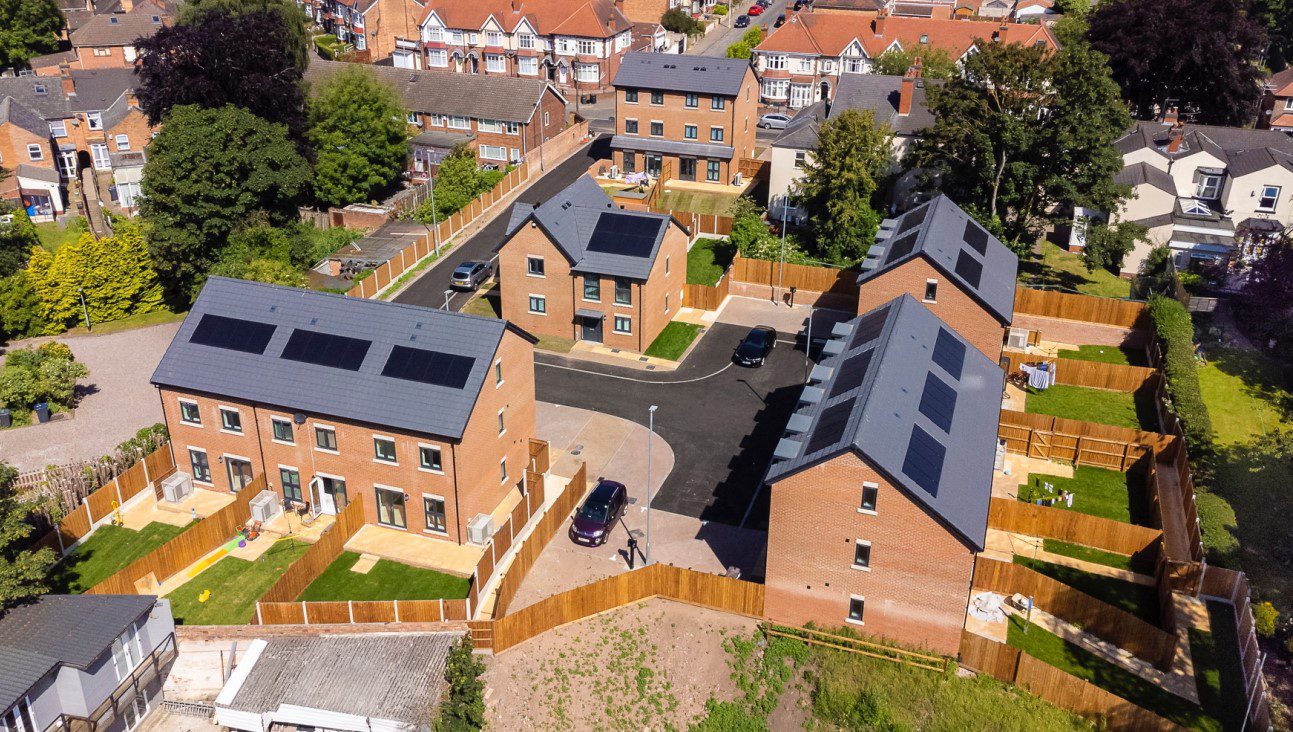
Midland Heart have produced an excellent case study on their recent completion of homes intended to comply with the Future Homes Standard. The standard aims to ensure that all new homes built from 2025 will produce 75-80% less carbon emissions than homes built under 2013 regulations.
Project highlights
- 12 homes, 3 different solutions successfully delivered
- Adapted conventional house types and masonry construction
- Designed to 80-90% reduction in carbon compared to 2013 regulations
- 70% carbon reduction with heat pump and PV compared to gas
- Heat pumps deliver over 20ºC even when outside -7ºC
- Monitored and Occupant Interviews over 1 year since occupation
- Scheme 15% more expensive overall but included early adoption and variety cost
- Small reduction in bills
- Occupants delighted with comfort
- Learning: Occupants, Heat Pumps, Controls, Supply Chain
The full case study is available to download from Midland Heart’s website [1].
Detailed summary
Midland Heart decided to make the Eco Drive development near Birmingham a demonstrator that would be designed and built to the anticipated 2025 regulations. The goal of the demonstrator was to show how the standard could be achieved cost effectively without unintended consequences. The scheme of two-, three- and four-bedroom homes, used standard house layouts and was adapted from the original 2013 Building Regulations design to meet the notional 2025 Future Homes Standard.
Birmingham City University (BCU) was brought onboard to capture a case study of the development, to undertake detailed monitoring, and to engage with the occupants to record their experiences and lessons.
A team consisting of Midland Heart, designers, contractor, subcontractors, materials suppliers, specialists and BCU was set up to deliver the project in a collaborative and learning approach. The target for the Eco Drive project was to deliver an 80% reduction in CO2 emissions, from the 2013 designs, by increasing insulation in walls, enhancing the window specification, increasing the levels of airtightness, employing planned ventilation approaches, and using heat pumps and photovoltaic (PV) systems.
The 12 homes were given three different variations of solution involving two types of space and water heat pump, and a water heating only heat pump with electric radiators. All used traditional brick and block construction because it is the most common construction form in the UK. Four were built to a much higher low-energy specification, and all were given 2.2 kW of PV panels, beyond the standard, to help the occupants with rising energy costs. Work commenced on site in March 2021 and was completed in May 2022. The construction contractor overcame all the development issues including electrical utility supply, brickwork insulation and local conditions which caused programme modifications. The overall project was delivered with a 15% uplift in cost against the project designed to 2013 Building Regulations.
Uniquely, this project provides granular energy and environmental data. It also provides feedback from occupants on their experiences of using heat pump and ventilation equipment. Monitored data were analysed visually in graphs at both a daily period using minute data and over monthly periods. These data showed how equipment operated, how the houses responded, and how the occupants’ lifestyles affected operations. This monitoring of energy use and environmental conditions showed that heat pumps could provide very comfortable conditions even in very cold periods. The series of interviews with the occupants showed the tremendous success of the project; in particular, the occupants found the added comfort a pleasure after their previous poor housing conditions. Total volatile organic compounds (TVOC) and fine particles (PM 2.5) increases were related to cooking activity, which in some homes could be for six hours a day. These parameters subsided when cooking stopped showing that ventilation was successful.
The daily pattern of heating showed high energy use in most houses and lifestyles often put pressure on the environmental conditions. However, the houses, which had heat pumps and PV, worked to their design performance targets and have achieved an estimated 70% reduction in carbon production against the use of the same house with a gas boiler; this percentage will rise as the electricity grid is decarbonised. The lessons learnt suggest that the occupant lifestyle is a key factor in achieving the Future Homes Standard targets and more needs to be done to assist them in understanding heat pumps, controls, ventilation and building performance. The heat pump operation needs to be explained in an explicit strategy and there is an opportunity for those maintaining the equipment to provide an annual refresher to occupants to improve in-use performance. Similarly, a ventilation strategy needs to be properly produced and explained with the identification of possible problems when floor, door and windows are modified.
The supply chain required to achieve the Future Homes Standard needs to be expanded and trained because the complexity of the changes cannot be understood without experience; this supply chain needs to include maintenance as an essential service. There needs to be a more comprehensive monitoring of equipment and house environments to better understand operations but also to feedback to occupants about how their lifestyles influence the performance of their houses.
